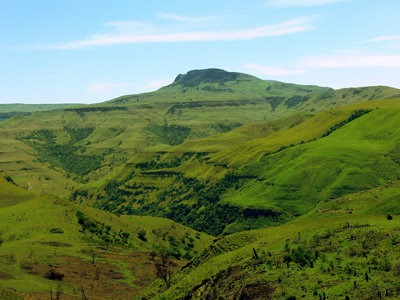Zululand, Natal and Transvaal, South Africa
The settlement of South Africa in the 19th century has a very turbulent history and it was especially true in Zululand, a province in northern Natal where the Zulus lived and farmed. It was not helped by a dispute between the Zulu king Cetywayo and the British about the position of the boundary between Zululand and the Transvaal, which the British took possession of in 1877. This boundary dispute quickly led to the Zulu War of 1879 which was the greatest of the wars fought by Europeans against African natives.
The Zulus became a highly organised and disciplined people when their most outstanding king, Chaka (Shaka), who was both clever and cruel at times, took control in 18th century. He formed great impis (Zulu regiments) which killed anyone in their way with merciless efficiency. After Chaka was murdered in 1828 he was succeeded by his half-brother Dingaan who was an agressive warrior and who repeatedly waged wars against the white men who were attempting to settle in the land. Dingaan was eventually overthrown by the Boers (Dutch settlers) and his more peaceful brother Panda became the new Zulu king. When Panda died in 1872 he was succeeded by his son Cetywayo who was much more like Chaka and Dingaan than his father.
The new Zulu king Cetywayo was clever and also strict, and his intention was to restore the Zulu nation to its former greatness. He kept a large army of young warriors who were forbidden to marry until each had killed an enemy. This was known as 'the washing of the spears'. With the British taking possession of the Transvaal province in 1877 this meant that the Zulus were now almost surrounded on all sides by the British Transvaal and Natal provinces. Irritated by this, the Zulus began sending small raiding groups into Natal causing the British settlers to live in constant fear of attack.
The British governor of the Cape and high commissioner for South Africa at the time, Sir Bartle Frere, felt that now the Zulus needed to be controlled so he issued an ultimatum to Cetywayo on December 11, 1878 which he knew would not be kept. He ordered Cetywayo to disband his army of warriors and to allow them to marry whenever they wanted to, to pay for the incursions into Natal and to allow British authority in Zululand. Cetywayo made no reply to these demands so the British prepared for an invasion of Zululand in January 1879.
The commander-in-chief of the British troops was Lord Chelmsford who crossed the border into Zululand with four columns of troops. The column led by Lord Chelmsford camped at Isandhlwana which was a hill a few miles away from Rorke's Drift. Ignoring the advice of the Transvaal Boers, Lord Chelmsford failed to protect his camp by forming a circle of wagons known as a laager. The Zulus saw that the British camp at Isandhlwana was badly protected and waited until Lord Chelmsford had left the camp with some of his forces before attacking and destroying it. The Zulu reserve warriors were not needed at Isandhlwana so they moved off quickly to deal with the much smaller British garrison at nearby Rorke's Drift. However, the British were prepared this time and managed to fight off the much larger Zulu force.
It took the British several months to prepare a much larger force and advance on Ulundi, the Zulu settlement where Cetywayo lived. This was the turning point of the Zulu war as the Zulus were defeated by the British. The Zulu king Cetywayo eventually surrendered and was imprisoned in Cape Town.

